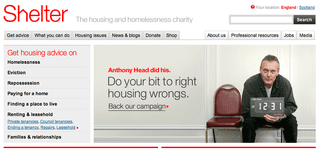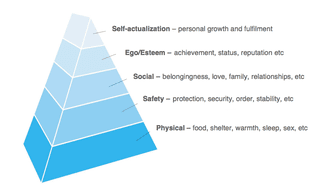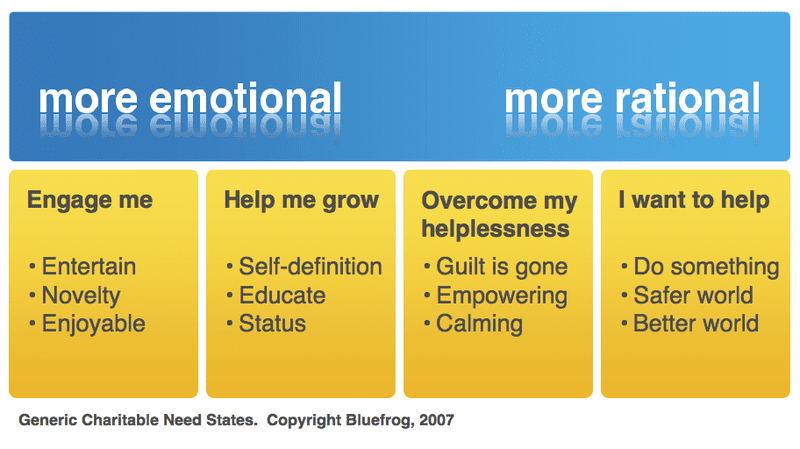Donors have needs too
There's a polyhedron that is almost as important to fundraisers as the pyramids were to the ancient Egyptians. You'll see it time and time again in books on fundraising and projected on giant screens at conferences. It was proposed by Abraham Maslow in 1943 in his paper, A Theory of Human Motivation, and is known as Maslow's hierarchy of needs.
At a simple level, it states that we approach problems of life in order. We need basics such as food and water, then somewhere safe to live, then friends, then a means to show everyone else how great we are and finally, when we have all those sorted we look at self-actualisation – which is a wide ranging term that means a whole host of wonderful things such as the appreciation of beauty, the understanding of truth and desire for order. Some people disagree with the linear nature of the model but, by and large, I think it's pointing us in the right direction.
But what does this mean for us in the fundraising world? How does an understanding of needs help us raise money?
To help answer this, let's move away from the world of fundraising into the world of fizzy brown liquids. Let's talk about Coke.
A few years ago, in the face of a number of problems, the Coca-Cola company overhauled its drinks portfolio around a number of need states. Rather than focussing on channel specific marketing or aiming at simple geo-demographics, consumption or life stage groups, they looked at what needs consumers had for drinks (other than simply being thirsty) and came up with a list that included: refreshment, relaxation, hydration, energy boost, weight management and heart health (they have created a piece of research called the Consumer Beverage Landscape built on data derived from more than half a million "consumption events" by 80,000 people in 40 countries).
There are only so many ways that you can package or present a drink, but the use of need states was seen to revitalise the complete portfolio. In a speech given by Chairman and CEO, E. Neville Isdell in June 2006, he said:
"When people want to know why I'm optimistic about the future of The Coca-Cola Company, the need state map is why: because the opportunity is so enormous."
And the results seem to have been pretty spectacular. The Q3 2008 earnings transcript shows some pretty good numbers – earnings / share up by 17%, unit case volume up by 5%, revenue growth up by 9% and operating income up by 17%. All achieved in very difficult market conditions.
This has been achieved through an acceptance that after 120 years of selling more drinks than any other company, Coke didn't understand the full universe of consumers need states. Innovation followed and new products, packaging and markets has driven growth in sales with Coca Cola Zero (a diet coke not called Diet Coke) growing by 30% in Q3 alone.
So what's this got to do with raising money?
Well, donors have needs too.
And perhaps we, in the charity sector, are a little like Coca Cola was a few years ago and are not really taking need states into account. But what would thinking about our donors in terms of their needs do for us?
Most importantly it would change the focus of our communications. It might be painful to hear, but most donors want to know what their gift can do (and has done) rather than read about what a charity does. it's a very subtle difference, but a massively important one.

Far too many charities focus on themselves.
Communications are about their work, their projects, their actions. Take a look at any charity web site and you are almost guaranteed to see what we do in a navigation bar well before what you can do. There are few that are like Shelter which takes a donor centric approach.
Look at your own website and ask yourself where does it place your donors? Does it make them feel like they are valued and an important part of your charity? Does it empower them or place them in the role of a bit player?
People give because they have a need to help. They don't give because they want a specific charity to do the work. By focussing on answering this need rather than just presenting a problem, we generate more money. I've seen it in results time after time.
But the need to help is just one need state that we have to address. In research, Bluefrog has found a number of needs that donors have. Some that are specific to causes, but most that are specific to them as people who give – they need a route for growth, they need to combat feelings of helplessness and they need to be engaged (maybe that word should actually be entertained).
In terms of potency, needs are far more powerful than values in generating loyalty and maximising income.
Why not look at your own donors and ask yourself what needs they have and try placing them at the centre of your next brief (or appeal, if you write them yourself). If you do it successfully, I think you will be pleased with the outcome.
I'd be more than happy to chat through your thoughts with you and share some of our findings if it would help. Just drop me a line at [email protected] or click the link just under my photograph.
Tags In
Related Posts
6 Comments
Comments are closed.
The Essentials

Crack the Code to Regular Giving: Insights, Strategies, and a Special Giveaway!

‘Tis Halloween. Keep to the light and beware the Four Fundraisers of the Apocalypse!

Why do people give? The Donor Participation Project with Louis Diez.

A guide to fundraising on the back of a postcard

What does the latest research tell us about the state of fundraising?








Hi Mark,
This is a very useful article. I enjoyed it a lot.
It was very hard to read though. I had to work hard at it. Now my eyes are tired.
However, since I put forward the time and effort to overcome that barrier I am going to use these ideas and share this with others around here. So thanks!
Hi Kimberley
Thanks for your comments. I’m glad you like the content though I’m sorry I hadn’t made it easier to read. I’ve looked at the copy and tweaked it. I’ve also looked at the layout. Hopefully you’ll agree its made it a little more accessible.
It’s based on an hour long presentation and compressing it into one short post was not as easy as I thought.
But thanks for passing it on to your colleagues. Maybe the next time I’m in Canada, I could share the original presentation with you?
Best wishes
Mark
Thanks Mark, that is much easier. I just posted a book myself! Glad to hear some of you hop the pond once in awhile!
Great stuff!
Thanks for sharing. I just checked out Shelter and I love their donor centered “What You Can Do” approach. We’re in the middle of launching 2 new websites. I’ve printed screenshots of a couple Shelter page and am going to be sharing them with our new Executive Director. Thank you, Mark!
Hi Katherine
I’m glad you like it. Thanks for reading and commenting.
[…] be successful – even at the basics – you need to understand what your donors’ needs are and why they want to give to you. Only when you understand that inside and out, can you start […]